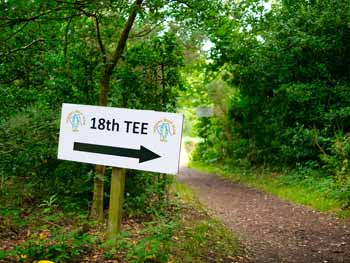Right of way or no right of way?
If a public footpath, bridleway or byway crosses a golf course there is a legal right of way for the public to cross that golf course. The method that can be used to cross the golf course will depend upon the type of right of way:
- Public footpath – on foot only
- Bridleway – on horseback, cycle or foot
- Byway – on horseback, cycle, foot or in a motor vehicle.
The right of way will be restricted to the route of the footpath, bridleway or byway and if anyone strays off that route they will become a trespasser.
Where a public right of way does exist, the landowner may NOT:
- Obstruct or block the path
- Put up notices to deter users of the public right of way
- Take down footpath / bridleway / byway signs
- Cause use of the public right of way to be hazardous (for example in danger of being hit by a golf ball).
A duty of care will be owed to a person using the public right of way by users of the golf course and / or the golf course owner itself, so care must be taken to avoid injuring users of the footpath. The golf course should ensure that its insurance arrangements extend to users of the right of way, as well as taking steps to warn users of the right of way of the potential hazard of flying golf balls with appropriate signage. As far as golfers are concerned, again they should be warned with signage that they should not hit until it is safe to do so (such as when walkers are out of range) and that they must shout a warning in the event of an errant shot. This could be reinforced with circulars to members, information on the club website, scorecards and warnings to visitors upon check-in. The issue could be further covered in the club constitution and in any documents sent to visitors when making a booking.

Right to roam
The Countryside and Rights of Way Act 2000 (‘CROW’) introduced the ‘right to roam’ giving the public the right to enter and remain on ‘access land’ for open-air recreation. It may be alleged by non-players walking on the golf course that they are exercising their ‘right to roam’ and that the golf course is ‘access land’.
For the purpose of mapping ‘access land’, Wales (for example) has been split into 14 regions. The maps show which land for a particular region is classed as ‘access land’ and can be viewed by going onto the Countryside Council for Wales website. However, if a golf course is shown on the map it does not mean that it will be subject to the ‘right to roam’. This is because it does not apply to ‘excepted land’, which is not shown on the maps. Golf courses are included in the list of ‘excepted land’.
Therefore, no-one has the right to access a golf course by virtue of CROW alone. Anyone who purports to do so will be a trespasser.
Please note that the legislation in Scotland is different and our Scottish members are directed to the document on www.ngcaa.co.uk in the members’ library entitled ‘Right to Roam Scotland’ under the heading ‘Property’.

Informal access rights
It is quite common for golf courses to tolerate local people walking through the course to get to their neighbouring properties, or as a shortcut. Golf courses should be wary of allowing people to access the land informally because there is a risk of:
- liability to the walker in case of injury; and
- creating a legal right for the benefit of either that person or the public over their land, by virtue of prescription.
Regarding the first, golf courses should ensure that they carry sufficient insurance. Regarding the second, a right of way by prescription is created where:
- The right of way has been exercised for at least 20 years without interruption and has been exercised ‘as of right’, that is without force, secrecy or permission; or
- The right of way has been exercised for 40 years with no written consent to use (and still without force or secrecy).
For the avoidance of doubt, use by persons in the usual course of the business of the golf course (such as members and so on) will not create a prescriptive right as these users are using the golf course with permission.
If someone does genuinely need access to your golf course, for whatever reason, then you can reach a written agreement whereby prescriptive rights can be excluded. This will avoid the situation of rights accruing over a long period of time.
How do I know if rights of way affect my golf course?
Rights of way over property are revealed in the following ways:
- Official copies which detail the title to the property will list any rights affecting the land resulting from the transfer of the land or as a result of any registered deeds of grant.
- Local authority search carried out when the property was purchased (footpaths, bridleways and byways are revealed by this search). This information is contained on the definitive maps held by the Highways Authority. It is possible to contact the relevant Highways Authority in order to request details of public rights of way passing over an area of land.
- Unregistered access agreements or deeds of grant held by the landowner.
- Knowledge of and an inspection of the golf course to ascertain whether any informal rights of way are being exercised.
This article is not intended to be a complete coverage of the topic. Professional advice should always be taken on the application of the law in any particular case. For further advice, please contact Alistair Smith at the NGCAA on 01886812943 or office@ngcaa.co.uk















Rights of way and other on golf courses on public parks are a nightmare.